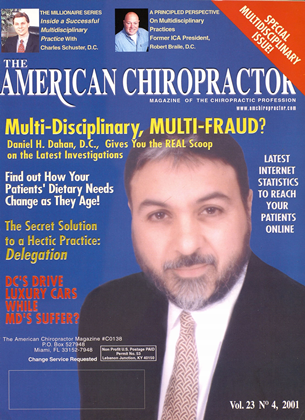Homeopathy is a 200-year-old health care system. Its founder, Samuel Hahnemann, M.D., wrote a guideline to use homeopathy called The Organon of Medicine1. In this text, written in German, he detailed all aspects of this system. The goal of the homeopathic system is to enhance the body's self-defenses through the "law of similars". This requires finding a substance that, when given in a highly dilute and succussed or "dynamized" dosage will produce the same symptoms that the patient is experiencing; this is the "like cures like" premise of homeopathy. The focus of action with the diluted and "dynamized" or energized dose of a substance is the stimulation of the individual's healing forces. The more closely the symptoms produced by the remedy are matched to the particular set of symptoms in the affected individual, the more likely the remedy will work.2 From a more modern viewpoint, homeopathy is thought to result from stimulation of biological defense and recovery mechanisms by the use of compounds according to the similia principle. The current scientific interpretation of the "law of similiars" suggests that any state of disturbance not corrected spontaneously may be corrected by minute doses of compounds. At a high dose (highly dilute and potentized), the same compounds can produce effects closely resembling the symptoms of the disease being treated.3 Studies have shown the immune system reacts more favorably to stimulation similar to itself. This means that a stimulatory action occurs when the introduced molecule resembles that of a "protector protein", such as those found in the immune system; this response is referred to as specificity of the low-dose effect.4 The homeopathic remedy must always be "recognized" by the receiver (cell, animal, or patient), according to either the law of identity, the similia principle, or as an endogenous molecule.5 Historically, following it's conception in Germany, homeopathy was transported to France, Britain (and it's colonies) and the U.S. In the U.S., this system achieved a great stronghold and following. By the 185O's and 186()'s, homeopathy was well established on the medical scene. Its practitioners were to be found in most communities. It had its own schools and literature and its medicines, which were being sold in both homeopathic and allopathic pharmacies. In reaction to this financial success, in 1848,the A.M.A. (American Medical Association) was chartered. This business-oriented guild generated great efforts to eliminate the homeopathic community. By the early 1900's. many forms of alternative therapy, including chiropractic, had been invalidated by the A.M.A. Primary status and financial gain were achieved for the practitioners of traditional western' medical or "regular medicine".6 While homeopathic continued to be the treatment of choice in India, it did not regain a foothold in European countries and the U.S., until the 1960's. With the combination of renewed interest in homeopathic treatment, training, availability of information and the public interest in alternative medical treatment, homeopathy experienced resurgence. In addition to case history interviews and analysis particular to homeopathic treatment, this system involves inges-tion of sugar pills coaled with a home- opathic tincture, or ingestion of a homeopathic tincture. This is a different approach to stimulating the vitality than is chiropractic; however, the premise of homeopathy is similar to chiropractic principles. Homeopathy attempts to stimulate the Vital Force, and chiropractic is based on Life Force principles. Homeopathy is a natural, holistic complementary medicine, and is highly compatible with chiropractic. A recent study reported that 43% of chiropractic doctors surveyed utilized homeopathy with patients.7 Homeopathy is a non drug, non surgical type of therapeutic intervention, that is able to render pain control, speed healing time and address the patient's emotional, psychological needs. For chiropractic physicians, this method has proven very effective in augmenting adjustive techniques. Currently, many homeopathic pharmacies make acute care, easy-to-dis-pense homeopathic remedy kits available to the public, as well as alternative health care practitioners. For more complicated or serious acute treatment, as well as on-going or chronic "constitutional" care, homeopathic training is recommended. The benefit of homeopathy to the chiropractic practice is far-reaching. This is an excellent adjunct in a multi-disciplinary setting which places the chiropractic adjustment first. Dr. Jonice Mae Owen is a 1986 graduate of Life Chiropractic College West, a Fellow of the American Board of Orthopedics, a Qualified Medical Examiner for the State of California, and a classically trained homeopath. She practices in the San Francisco Bay Continued on Page 43 NUTRITION ...from Page 32 Area, and is currently completing a Master's of Applied Science program in Musculoskeletal Studies through the Royal Melbourne Institute of Technology/Southern California University of Health Sciences (formerly LACC). You may contact Dr. Owen at: nun .low enchiro.com or: owendefs'inind.sprine.com. References: Samuel Hahnemann. M.D.. The Orgtuum of Medicine. Publisher: B. Jain Publishers Rvl.. Ltd.. New Delhi. India. Kent. J. T.. M.D.. Lectures on Homeopath ic Mdteria Medica. Publisher: B.Jain Pub lishers Rvl. Ltd.. New Delhi. India. Van Wijk. R.. Wieganl. F.. "The similia principle as a therapeutic strategy": A research program on stimulation of self- defense in disordered mammalian cells. Alternative Therapies. March 1497. Vol. 3.. No. 2. p. 33-38. Van Wijk. R.. Wieganl. F.. "The similia principle as a therapeutic strategy": A research program on stimulation of self- defense in disordered mammalian cells. Alternative Therapies. March 1997. Vol. 3. No. 2. p. 33-38. Bastide. M. Lagache. A. "A communica tion process: A new paradigm applied to high-dilution effects on the living body. Alternative Therapies. July 1997. Vol. 3. No. 4. p. 35-39. Coulter. Harris. Divided Lct;acy:Tlhe con flict between homeopathy and the Ameri can Medical Association: North Atlantic Books. Berkeley. CA. p. 241. Hawk. C. D.C. ft. <//.. "Use of Comple mentary Healthcare Practices among Chi ropractors in the United States": A Snney Alternative Vicnipies. Jan.99. Vol. 5. No. I. ■
 View Full Issue
View Full Issue









